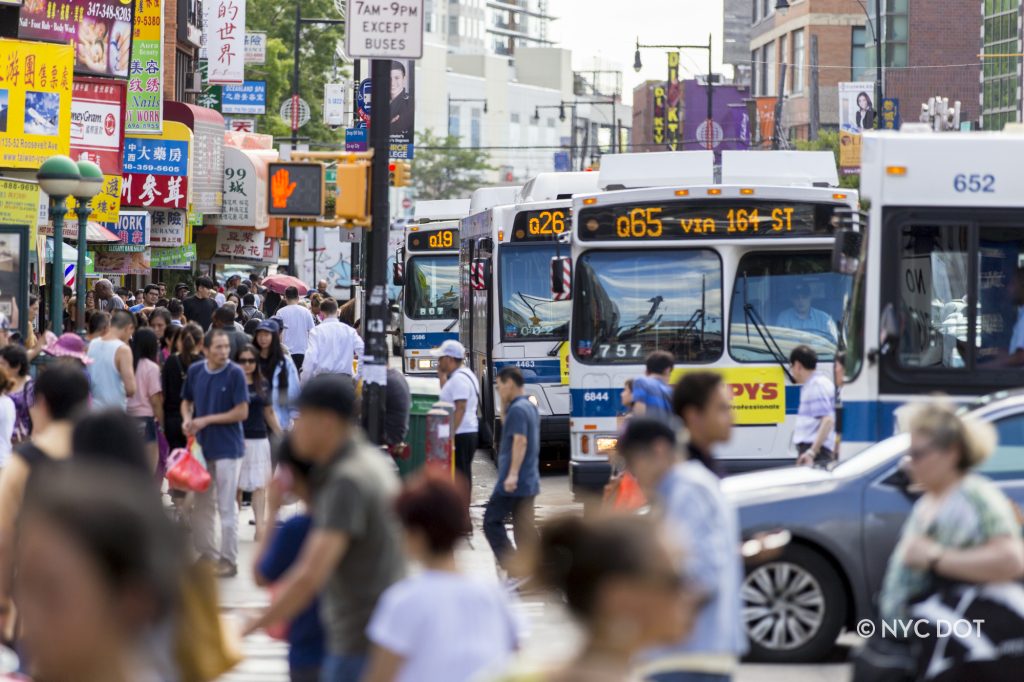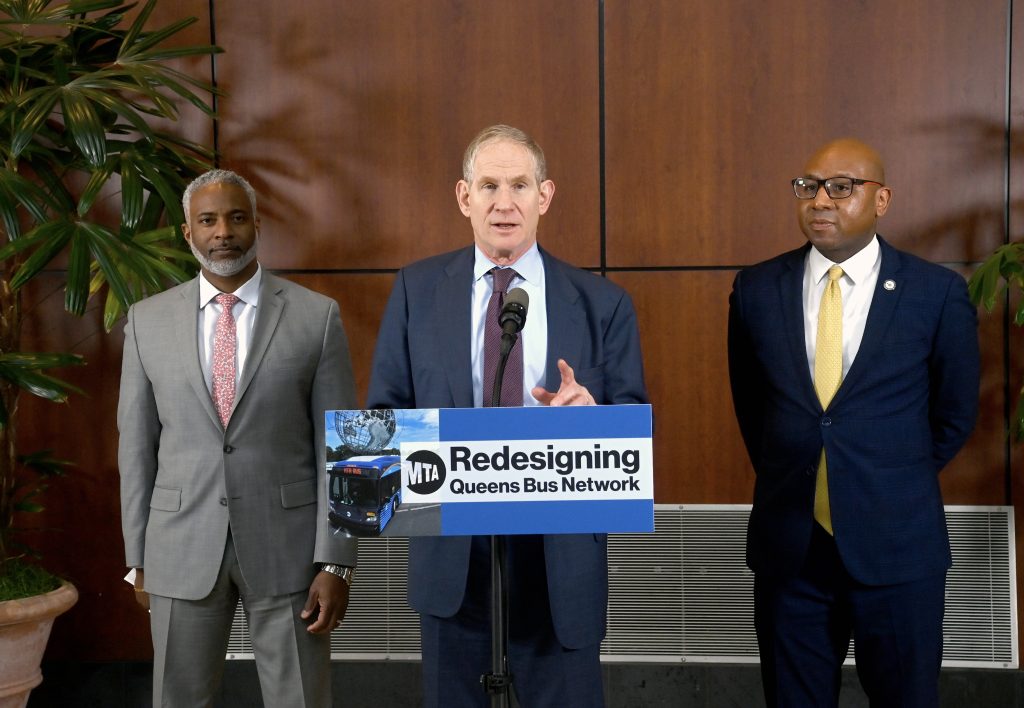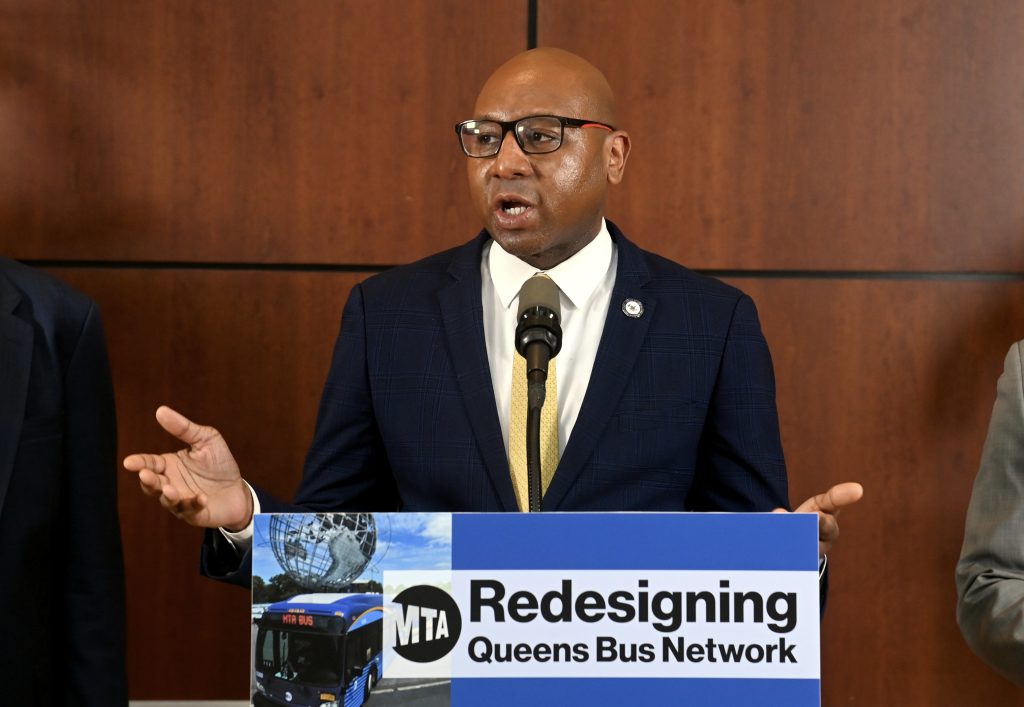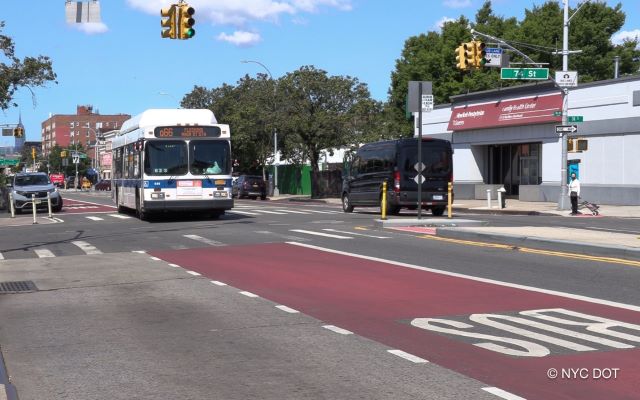
MTA Buses in Flushing, Queens
By MOHAMED FARGHALY
mfarghaly@queensledger.com
The Metropolitan Transportation Authority (MTA) has released the final version of its Queens Bus Network Redesign, marking a major overhaul of bus service across the borough — and one of the most ambitious transit restructuring efforts in the city’s history.
The new plan, which has been years in the making, aims to modernize bus routes to better reflect the current travel patterns of Queens residents. Beginning this summer, sweeping changes will be implemented in two phases — on June 29 and August 31 — to streamline service, improve reliability, and shorten travel times for riders.
Under the redesign, the number of total routes will grow from 113 to 124, consisting of 94 local routes and 30 express or “rush” routes. These routes fall into four main categories: Local Routes that connect neighborhoods; Limited Routes, which offer faster connections along key corridors; Rush Routes, designed to move riders from neighborhoods to major hubs; and Select Bus Service (SBS)/Crosstown Routes, which operate as bus rapid transit on high-demand routes with limited stops.
“800,000 Queens residents depend on our buses every day, and we owe it to them to find new ways to speed service,” said MTA Chair and CEO Janno Lieber. “No matter what else is going on in New York right now, the new MTA is listening to our customers and delivering bus speed improvements – whether it’s by transformative redesign of the bus network, Automated Camera Enforcement, or congestion pricing.”

MTA Chair & CEO Janno Lieber, NYCT President Demetrius Crichlow, and Queens Borough President Donovan Richards announce the two-phase implementation of the Queens Bus Network Redesign at Queens Borough Hall on Monday, Apr 7, 2025. (Marc A. Hermann / MTA)
In Phase One, the MTA will launch 16 new routes, modify 67 existing ones, and discontinue five. Phase Two will bring one new route, changes to 37 existing routes, and the discontinuation of one.
The finalized plan follows years of planning and public outreach. Since 2019, the MTA has hosted more than 250 events and collected roughly 18,000 comments from riders, elected officials, and community members. The plan was formally approved by the MTA Board in January 2025.
“Starting this summer, bus riders in Queens will get to experience an enhanced, efficient and modern bus network, holistically designed for the future, not the past,” said NYC Department of Transportation Commissioner Ydanis Rodriguez. “We are proud to support the implementation of this redesign in partnership with the MTA to deliver enhanced bus service and bus stops for Queens riders, and we will continue to develop and implement bus priority projects that complement the Network Redesign service changes.”
The MTA has rolled out a suite of digital tools to help riders navigate the upcoming changes. A new route look-up tool at mta.info/queensbus allows riders to check specific route changes and timing, with translation features powered by Google Translate. Riders can also preview the new network using Remix, an interactive mapping tool, or explore their future commute using the Future Trip Planner, which shows trip options based on the fully implemented network.
In preparation for the changes, NYC DOT is currently updating signage at bus stops across Queens. GAR boxes — the permanent information panels at bus stops — will soon display redesign-specific updates, and signage inside buses and subways is also being rolled out. Onboard announcements and community outreach, including pop-up events and presentations to community boards, are part of an education campaign that began earlier this year.
Transit officials say the project will deliver clear benefits for riders: improved neighborhood connections, simplified routes, increased service frequency, and more consistent spacing between stops — all of which are expected to result in faster, more reliable service. Key corridors will also benefit from Bus Priority Projects, which aim to reduce delays and improve the overall rider experience.
“The Queens Bus Network Redesign is a game-changer for the 800,000 borough residents who ride an MTA bus each day. As we prepare for the official rollout of the redesign this summer to speed up commutes and make our system easier to navigate, I encourage all our straphangers in Queens to get informed on potential changes to your most frequently used routes,” said Queens Borough President Donovan Richards Jr. “I was proud to work hand-in-hand with the MTA and all our partners on this plan and I couldn’t be more excited to see what a world of difference it will make in the daily lives of our neighbors as they travel to work, school and everywhere in between.”

Queens Borough President Donovan Richards announces the two-phase implementation of the Queens Bus Network Redesign at Queens Borough Hall on Monday, Apr 7, 2025. (Marc A. Hermann / MTA)
While the MTA touts the Queens Bus Network Redesign as a long-awaited step toward modernization, some longtime residents remain skeptical about its actual impacts
Michelle Cook Lopez, a lifelong Queens resident and small business owner in Glendale, brings a deeply community-rooted perspective to the Queens Bus Network Redesign. She operates Cook’s Arts and Crafts, a family-run yarn and hobby store that’s been in business since 1970, started by her grandmother. Beyond her store, Michelle is involved in the local American Legion and property owners’ association, giving her a strong pulse on neighborhood concerns. From her apartment above the store, she’s witnessed firsthand how essential accessible transit is for her community, particularly for seniors, families, and people with limited mobility. “I saw it posted with a link of which bus stops they were going to be taking out, and I took a look at it, and I said, well, that’s stupid, because they’re taking away the one closest to CVS drugstore in Glendale.”
While Michelle acknowledges that some changes to the bus network might be justified—especially stops that are unusually close together or in low-traffic areas—she’s particularly concerned about the removal of key stops in Glendale along the Q55 route. One is near the CVS drugstore, a lifeline for many elderly residents who may struggle with the added distance. Another is in front of Ideal Supermarket, which she sees as not only a blow to local businesses but also a challenge for shoppers managing groceries. Michelle emphasized she’s not just thinking of herself, “I can walk a bit of ways, I don’t mind so much for me personally, but a lot of seniors in the area use CVS, and now they’re going to have to walk an extra two to three blocks to get to the nearest bus stop.”
Linda Zimmer, a longtime Queens resident from Middle Village, has called the borough home for 67 years. Now retired, Linda once relied daily on the Q38 bus to connect her to the M train for her commute. Though no longer traveling for work, she still depends on that route for everyday errands. With the upcoming Queens Bus Network Redesign, Linda is facing a new challenge: her local stop on Juniper Valley Road is being eliminated, forcing her to walk nearly half a mile through the park to reach the next available stop on Eliot Avenue. “I used to just walk to the corner,” she says, noting that the increased distance is especially tough for seniors like herself — particularly with two bad knees and the added obstacles of navigating through parks filled with bikes and scooters. For Linda, the redesign feels less like a modernization and more like a disruption to the routines and mobility many longtime residents rely on.
Customers are encouraged to visit www.mta.info/project/queens-bus-network-redesign/service-changes for more information to see if their route has been affected and to stay informed ahead of the upcoming launch dates.
The first phase of service changes takes effect on Sunday, June 29, followed by the second phase on Sunday, August 31, or the next regular service day.



